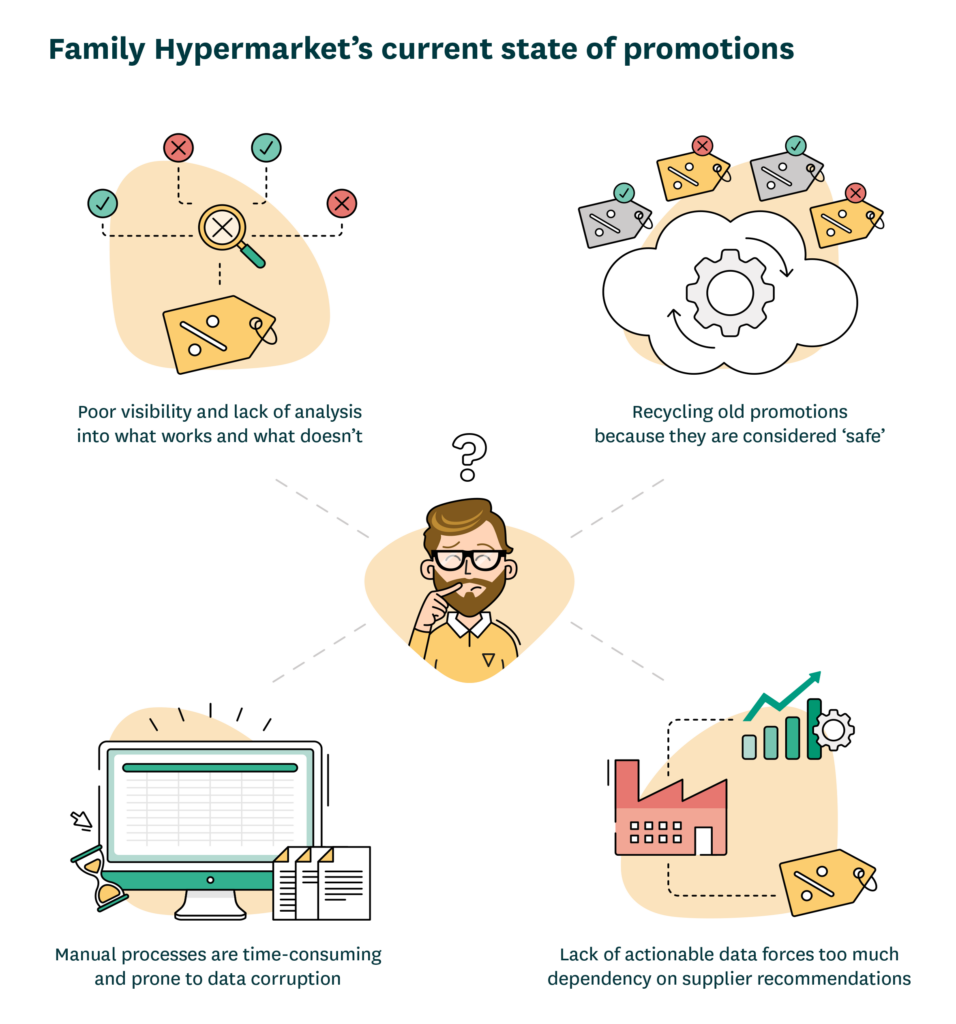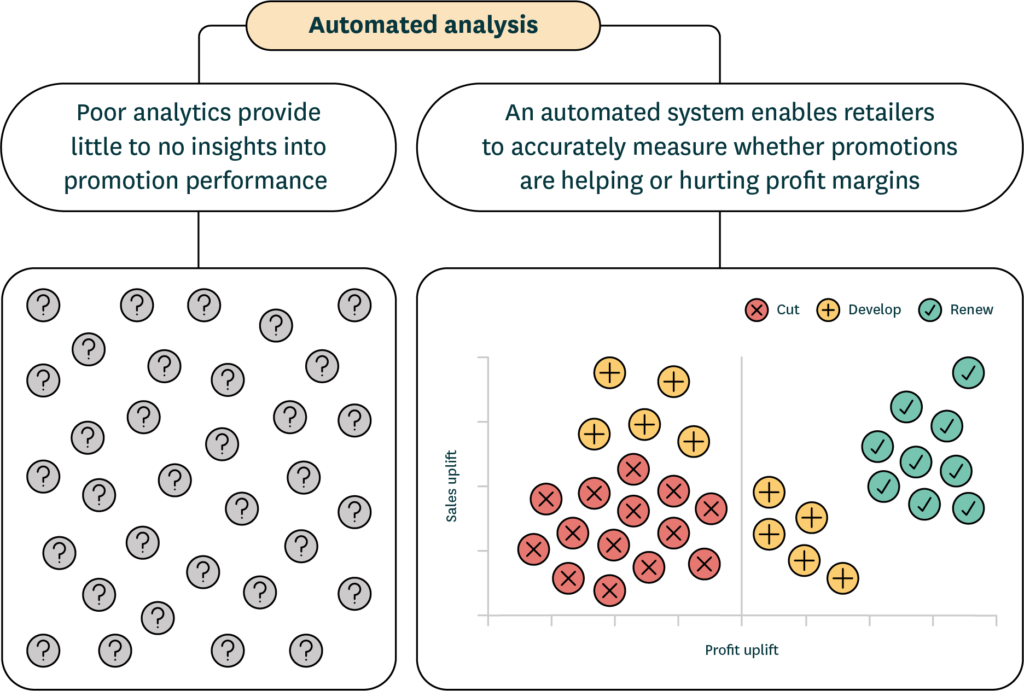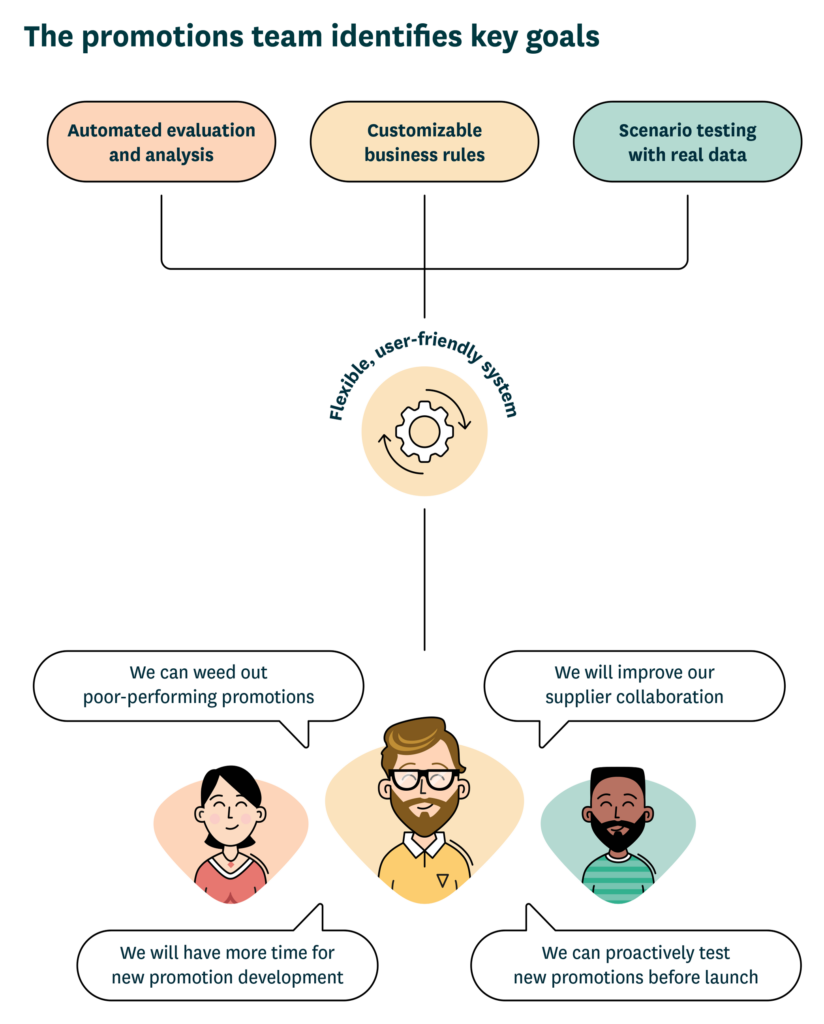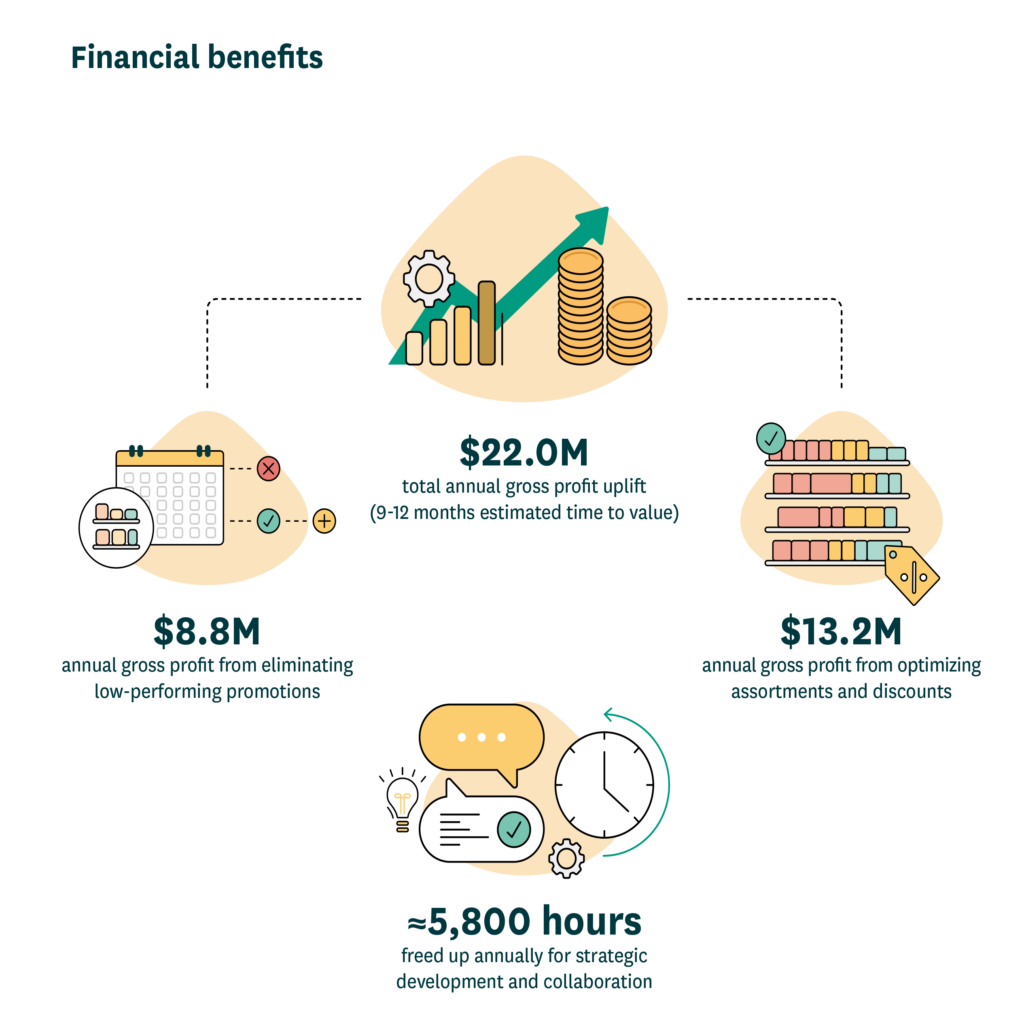Promotions are universal to almost all retailers and can drive up to 50% of sales and store traffic annually. They are essential to customer growth, help retailers shape the shopping experience, and play a significant role in the retailer-supplier relationship. So, why do retailers struggle so much with such a frequent and vital aspect of their success? The promotion process – high-level planning, optimizing offers, negotiating funds, and evaluating outcomes – is extremely difficult to do well.
For many retailers, promotion planning and preparation are done primarily in spreadsheets, which is time-consuming. Manual copying and pasting of data increase corruption risks or sheets crashing because they’re pushed to their absolute limits. As a result, retailers run promotions in a stressful and cumbersome environment without comprehensive and actionable insights into which promotions drive positive results, which merely create extra work, and which might directly damage the business. Modernizing and automating promotion planning and evaluation enables retailers to achieve three key goals:
- Improving promotion performance and impact on the business’ profits and margins.
- Making the promotion process operationally efficient and less prone to errors.
- Automating processes to save time and eliminate the need to manage promotions using spreadsheets or disconnected solutions.

1. Building the case: Family Hypermarket’s promotion planning & optimization needs
Family Hypermarket’s SVP of Supply Chain, Sue, and VP of Merchandising, Matthew, have both built compelling cases for technology investment in supply chain and space management, leading to successful implementations. Matthew is aware that his promotion planning team is struggling and sets out to build a case for investment in this critical area of Family Hypermarket’s business.
1.1 The first step is to assess the current state of Family Hypermarket’s promotion planning
Matthew sits down with Family Hypermarket’s team of 14 promotion planners to establish a clear understanding of the current state of their processes. Only when they have a complete picture of where they are today can the team determine the best and most impactful path to improvement.
Manual planning in spreadsheets makes it difficult to sync with other systems that contain much-needed information, such as product lead times or price shifts. Moving data from spreadsheets to other systems leads to issues with compatibility and increases data corruption and errors. Furthermore, spreadsheets are not ideal for processing the complex statistical models required to understand impacts such as promotion uplift and cross-category effects.

Retailers run thousands of promotions each year, and it’s laborious to analyze them in detail. With so many promotions running at a high frequency, the Family Hypermarket team must prioritize execution over evaluation to avoid falling behind. The spreadsheet-based analysis is either done superficially – “Did we sell more? If yes, run the same promotion again” – or only for those selected promotions considered more significant than the rest.
The team is in a cycle of running the same promotions every year because they lack actionable insights and time. Family Hypermarket doesn’t have adequate tools to identify and develop promising new promotion ideas, so the previous year’s campaigns are perceived to be the “safer” option. Further, manual processes take so much time that the team does not have any left to develop new campaigns. The result is that around 95% of promotions are copied year after year.
Suppliers tend to be the key driver in promotion development. Family Hypermarket’s consumer goods partners have a deeper understanding of data and insights, so they proactively suggest future promotions and offers. Since their internal capabilities to analyze and optimize promotions are limited, the Family Hypermarket team has no choice but to lean heavily on those supplier recommendations.
1.2 Matthew uses the current state to identify challenge areas and improvement needs
Automate promotion evaluation to maximize results
The team has little insight into how promotions perform across Family Hypermarket’s different stores or how they perform against each other. Matthew wants to implement a system that can provide automated evaluations of promotions at the store level and compare promotions throughout the year. These analytics will provide the insights the team needs to maximize promotional results by understanding which promotions drive sales and margin, which past promotions to prune out due to poor performance, and what products to include in promotional assortments and the optimal prices. Cutting off low-performing promotions also saves time that can be put toward developing new campaigns and strategies.

Enable scenario testing with real-life data to gauge performance proactively
The team is forced to launch promotions based on guesswork due to limited data from the previous year and no means to test upcoming promotions proactively. This situation perpetuates the cycle of accepting previous promotions as “safer options” and running them repeatedly with minimal updates. Further, when Family Hypermarket’s supplier recommends a promotion, the team cannot determine whether it is in their best interest, which leaves them little choice but to trust the supplier and hope for the best.
Matthew’s goal is to provide the team with a system that includes a scenario-testing environment for what-if analysis using actual data. Using their own data to test and adjust promotions proactively will enable the team to get a more accurate picture of the impact – positive or negative – of running them. It will also help Family Hypermarket work more confidently with suppliers when implementing their recommendations.
Provide a customizable set of rules to trigger warnings of potential execution pitfalls
Once the team schedules a promotion, they have little visibility into potential problems as the launch approaches and limited ability to proactively change promotions that may perform poorly or negatively impact margins due to changes in the market. They often don’t know there’s an issue until it’s too late.
Matthew is looking for a system that includes a flexible set of alerts that gives the team the power to, for example, prevent promotions that don’t preserve a minimum margin, trigger warnings if there’s not sufficient stock to fulfil a planned promotion or any number of other factors that are customized to their unique needs.
1.3 Matthew develops realistic improvement goals based on researched data and benchmarks
Matthew’s core goal is to empower the team to focus on analysis that drives the development of more promotions that deliver measurable value and strip away those that don’t. However, he knows that to make his case compelling to the business, he needs to build specific goals that will help him build realistic impact estimations.
Matthew has established that Family Hypermarket has a 22% average profit margin for promoted items, accounting for 14-15% of total gross profit. He expects to be able to increase those profits by 3-6% with a system that can provide automated analysis and enable planners to identify and eliminate promotions that drive neither profit nor revenue and shift focus to those that are proven to increase revenue and profit.
Beyond selecting what promotions to run or cut, Matthew expects that by optimizing the product assortments that go into promotions and the depth of the discounts applied, he can achieve a further 5-8% increase in promotion profit. Further, assortment and allocation optimization will decrease over or under-stocking, improving availability and reducing in-store workloads.
Matthew estimates a 20-25% reduction in time spent on manual tasks for his team of 14 planners. By eliminating manual work through automation, such as evaluating past campaigns, entering promotions manually into the ERP, and checking pricing. With this time, planners can develop new promotion ideas and run tests to establish the best promotions to execute and collaborate more efficiently with stores and suppliers.

2. Family Hypermarket’s business case for investing in promotion planning & optimization technology
Matthew is satisfied with his goals and is confident they can be achieved through his proposed technology investment. However, Matthew knows he needs to present his case in terms of financial benefits to convince Family Hypermarket’s leadership team to invest.
Matthew recalls his collaboration with Steve, a business controller from the CFO’s team, on the space management project. He calls Steve to help him once again translate his goals and expected benefits into potential financial impacts. Working closely with his preferred technology vendors, Matthew uses their experience with comparable previous projects to help refine his estimates. Even though he is presenting estimations of the benefits and impacts, Matthew needs to base them on real-life data and expertise. He also creates a list of intangible or “soft” benefits that he knows will be hard to quantify but are still vital to the business.
2.1 The financial benefits of improved promotion planning & optimization
Matthew’s first goal is to provide the team with the analytics needed to identify and eliminate low-performing promotions and increase the cadence of high performers. As a result, he estimates a 4%, or $8.8M annual gross profit increase for the promoted product range.
Matthew seeks to ensure that Family Hypermarket’s chosen promotions achieve maximum performance. To drive that performance level, the team needs to be able to optimize the product selection and discount depth for each promotion. He estimates a resulting 6%, or $13.2M annual gross profit increase for the promoted product range.
By meeting his primary goals, Matthew estimates a total annual gross profit uplift of $22M for the promoted product range. After meeting with his preferred technology vendor, he is confident in an estimated time to value of 9-12 months.
Additionally, Matthew’s estimated 25% reduction in time spent on manual planning. Of that time, 5% would be reallocated to new promotion planning, which will be highly automated when the project is fully realized. This reduction will save 8 hours per planner per week, totalling ≈5,800 hours annually they can spend on the strategic development of new promotions and supplier collaboration.

2.2 Considering the intangible benefits of retail promotion technology investment
Matthew has assembled a list of benefits that directly influence Family Hypermarket’s ability to meet their business goals – despite being difficult to quantify. He uses these benefits to strengthen his case and exhibit how promotion optimization technology investment will not only drive better promotion planning but ripple out and help drive efficiency in other areas.
- Synchronizing planning processes across functions. Family Hypermarket’s technology investment will help connect promotion planning to forecasting, replenishment, and space planning. Breaking down functional silos creates a seamless process where all teams work based on the same data, plans, and expected outcomes.
- Improving the retailer-supplier relationship. A better understanding of their promotions and an improved planning process will help Family Hypermarket and their suppliers as they strive for higher market share and negotiate supplier investments and trade funds. Family Hypermarket will be better equipped to evaluate suppliers’ recommendations for promotions to determine the best course of action for all, including the impacts on customer experience.
- Increasing forecast accuracy. When forecasting and replenishment planning teams have complete visibility into promotion plans and data, both teams can ensure the right products get to the right stores at the right time. This improved accuracy helps mitigate over or understock situations and drives efficiency for store operations teams.
- Reducing waste. Specialty and seasonal items, such as holiday chocolate and baked goods, require accurate forecasting and allocation to avoid excess stock at the end of the season. In many cases, fresh items on promotion are already approaching their limits. Optimizing promotion planning will help Family Hypermarket attain the correct product volumes and offer them at the best prices to avoid spoilage.
- Measuring the effects of stockpiling and switching. Effective promotion analysis and testing give Family Hypermarket improved insights into customer behavior in certain situations, such as seasonal events and economic changes. These insights give them an advantage when sudden market shifts occur, react more quickly when needed, and better forecast products and sources to meet customers” needs.
3. The key takeaway: Real data and collaboration drive the most reliable results
As Matthew and his colleagues have demonstrated, a compelling business case must be built on a foundation of a thorough current-state assessment and reliable, real-life data. Relying on benchmark data alone would not adequately represent Family Hypermarket’s unique needs or provide a realistic scenario for investment and long-term commitment.
Having taken the time to build a well-researched case, Matthew is confident in the findings and vendor selection he will present to Family Hypermarket’s leadership. Beyond justifying the investment, his business case is a valuable tool that will help him:
- Direct conversations with potential vendors to ensure they can meet Family Hypermarket’s needs.
- Establish clear priorities internally and with vendors to ensure teams work well together during the implementation process and throughout the relationship.
- Set measurable KPIs and milestones to guide the implementation process and continued evaluation of the solution.
When a retailer lacks certain information or has insufficient historical data around promotion planning processes, open collaboration with potential vendors can aid in selecting the most realistic figures possible for calculating estimates. Many vendors will be able to provide insight based on industry experience. However, it is essential to consider their customer references as a factor in the trustworthiness of their estimates.



